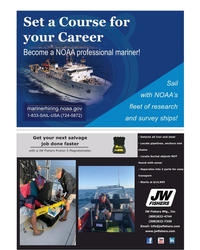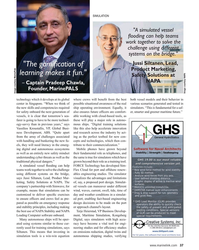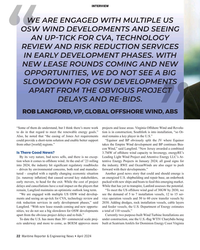Environmental Research
-
- Marine News Editor's Note Marine News, May 2015 #6
It is at times like this that bumper sticker humor comes in handy. One of my favorites has to be the infamous “God, please let me have another oil boom – I promise not to mess this one up” version that graced the bumpers of pickup trucks on the Gulf Coast in the late 1980’s. I lived through that cataclysmic event during my 14 years in Houston. It was in 1985 that the bottom had dropped out of oil, reaching a nadir of $12 per barrel. Using the time-honored Keefe family tradition of buying high and selling low, I eventually shed a primary residence and a three-unit rental property in the Bayou City during the worst of it.
It is okay if you find yourself inclined to ask, “So what?” It’s a good question. That’s because the Offshore Annual of MarineNews touches upon many things; none more important than the value of lessons learned. First and foremost amongst those is the mandate to not repeat the scenario that played out on the Gulf Coast in the late 1980’s. Back then, tens of thousands of workers (involuntarily) departed an industry that they had lost faith in, never to return. The void this created, even to this day, has left a generational and skills gap that quite frankly, the offshore sector hasn’t yet recovered from. We simply can’t afford to do that again. NOIA’s Randall Luthi and IMCA’s Jane Bugler touch on just a few of the reasons why. Turn the page and drill down for answers.
Safety and offshore energy are still inextricably connected. Beyond this, our expert commentators say that industry can’t turn its head from this reality ever again, even if the price of oil drops to 1986 levels. The trick will be how to accomplish that goal and still remain inside those scaled back CapEx budgets. It can be done. Inside this edition, you will find out how and why.
For those readers who need real data to support the notion that the oil industry can and does make it happen on a daily basis, look no further than this month’s BY THE NUMBERS entry, assembled by Dagmar Etkin, PhD, President and Principal Consultant at Environmental Research Consulting. Etkin, appropriately enough, examines the changing risks for offshore well blowouts in a statistical survey that sheds unique, balanced light on the real performance of the energy industry. While a catastrophic blowout scenario is a very rare event, contingency planning and preparedness, as well as technological advances in prevention will be important in the years to come. And when it comes to environmental research, nobody drills deeper than Etkin. The report starts on page 8.
Offshore Oil & Gas, Safety, Prevention, Response – and yes, oil pollution itself – all have a place in this month’s edition. Furthering the first four causes while eliminating the final challenge is what the industry is all about. And, you didn’t have to be selling real estate in Houston in 1987 to know that.
(As published in the May 2015 edition of Marine News - http://magazines.marinelink.com/Magazines/MaritimeNews) -
- OIL SPILL CONFERENCE Maritime Reporter, Feb 15, 1985 #30
at this ninth biennial meeting, which will be held at the Westin Bonaventure Hotel. It is sponsored by the American Petroleum Institute, the Environmental Protection Agency, and the U.S. Coast Guard. Conference delegates can choose from 110 presentations that will spotlight the latest pollution
-
- Rados-Designed Research And Monitoring Vessel Being Built By Knight & Carver In San Diego Maritime Reporter, Oct 1988 #48
new 84-foot twin-screw, full secondary research and monitoring vessel for the City of Los Angeles. The vessel, named Lamer (Los Angeles Marine Environmental Research), will be responsible for collecting water quality samples, and various other biological samplings, etc., primarily in the Santa Monica
-
- Sonardyne Aids NOC Marine Technology, May 2013 #38
it recorded video and imagery whilst collecting samples from the newly discovered vents in the Cayman Trough. The expedition, funded by the Natural Environmental Research Council (NERC), saw the researchers, from NOC and the University of Southampton, return to a set of vents – in the Beebe Hydrothermal Vent
-
- MTR100 '13 Aanderaa Data Instruments, a Xylem brand Marine Technology, Jul 2013 #32
, designs, manufactures and sells sensors, instruments and systems for measuring and monitoring in demanding environments. Its main market areas are Environmental Research, Marine Transportation, Oil and Gas, Aquaculture, Road and Traffic and Construction. Aanderaa is known for its ability to develop uncompromising
-
- MTR100 '13 Turner Designs Marine Technology, Jul 2013 #76
that it supplies more filter fluorometers than any other company. Turner Designs provides innovative fluorescence-based solutions for basic environmental research, water quality analysis, environmental monitoring, and pollution control analysis. Turner Designs is continuously expanding its repertoire
-
- MTR 100: Texas A&M University at Galveston Marine Technology, Jul 2014 #77
the Wetlands Center, Seafood Safety Lab, Sea Life Center Research Lab, Center for Texas Beaches and Shores and the Laboratory for Oceanographic Environmental Research. Campus waterfront operations include a fleet of floating classrooms and laboratories with immediate access to the ocean and Galveston Bay
-
- 'How-To' Manual For Oil-Spill Cleanup Available From EPA Maritime Reporter, Mar 1980 #9
The U.S. Environmental Protection Agency has released a comprehensive "Manual of Practice for Protection and Cleanup of Shorelines" from oil spills. The two-volume manual was prepared by Woodward-Clyde Consultants (San Francisco). The manual is designed as a decision-making guide to provide the
-
- Halls of Higher Learning Marine Technology, Aug 2016 #46
the Planet. The journal Nature ranked the academic institution of UC San Diego first in the United States and fourth worldwide in earth and environmental research. QS World University Rankings 2016 in Earth & Marine Sciences placed UCSD as 14th in the world. The National Oceanography Centre (NOC) Topic
-
- MTR100: Turner Designs Marine Technology, Aug 2016 #53
Turner Designs provides innovative optical-based solutions for environmental research and monitoring, water quality analysis and pollution control analysis. Having a unique focus on fluorescence instrumentation for over 40 years and customers throughout the world, Turner Designs is a leader in filter
-
- MTR100: Sea-Bird Scientific Marine Technology, Aug 2016 #26
monitoring of physical and biogeochemical properties. Sea-Bird products are used across industries, all over the world in numerous critical environmental research and monitoring efforts, ranging from determining the ocean’s role in, and the associated impact from, climate changes to the monitoring of
-
- MTR 100: Turner Designs Marine Technology, Aug 2015 #10
FluoroSense, a small, handheld device which enables quick field sampling in the water stream. Turner Designs provides optical-based solutions for environmental research and monitoring, water quality analysis, and pollution control analysis. Having a unique focus on fluorescence instrumentation for more than
-
 )
March 2024 - Marine Technology Reporter page: 45
)
March 2024 - Marine Technology Reporter page: 45ronments. The new agreement will address speci? c techni- cal gaps in the UUV defense and offshore energy markets especially for long duration, multi-payload mission opera- tions where communications are often denied or restricted. As part of the new alliance, Metron’s Resilient Mission Autonomy portfolio
-
 )
March 2024 - Marine Technology Reporter page: 41
)
March 2024 - Marine Technology Reporter page: 41Image courtesy Outland Technology Image courtesy Exail Image courtesy Submaris and EvoLogics Vehicles The ROV-1500 from Outland Technology represents a leap forward in underwater robotics, a compact remotely operated vehicle (ROV) weighing in at less than 40 lbs (19kg) the ROV- 1500 is easy to transport
-
 )
March 2024 - Marine Technology Reporter page: 35
)
March 2024 - Marine Technology Reporter page: 35Figure 1 A self-righting vehicle design with buoyancy high and weight low, WHOI’s SeaBED AUV captures the attention of a pair of curious Antarctic penguins as it is deployed from the British research vessel James Clark Ross. Vehicle designers allowed for temperature reduction of battery capacity. Recharge
-
 )
March 2024 - Marine Technology Reporter page: 30
)
March 2024 - Marine Technology Reporter page: 30es the necott. “The focus since then has been on scaling while en- wave, current and vessel motions that in? uence loads in the suring the lightest environmental impact,” says The Metals power umbilical. The LARS can operate in up to 3.5m wave Company CEO Gerard Barron. In-? eld collection system tri- height
-
 )
March 2024 - Marine Technology Reporter page: 29
)
March 2024 - Marine Technology Reporter page: 29n January, Norway said “yes” to sea- bed mining, adding its weight to the momentum that is likely to override the calls for a moratorium by over 20 countries and companies such as I Google, BMW, Volvo and Samsung. Those against mining aim to protect the unique and largely unknown ecology of the sea?
-
 )
March 2024 - Marine Technology Reporter page: 27
)
March 2024 - Marine Technology Reporter page: 27SEA-KIT USV Maxlimer returning from HT-HH caldera in Tonga. © SEA-KIT International data and further assess ecosystem recov- ery. What is known, noted Caplan-Auer- bach, is that the impact of submarine vol- canoes on humans is rare. “The HT-HH eruption was a tragedy, but it was very unusual. It let us
-
 )
March 2024 - Marine Technology Reporter page: 25
)
March 2024 - Marine Technology Reporter page: 25Portable System Requires only UK, Maxlimer mapped the shape of the Wavelet 2KW at 250ms Ping Rate CorrelaO on > 0.96 caldera and measured the environmental conditions of water above it. Sensors on board collected additional data, explained SEA-KIT Operations Director Ash Skett, including bathymetric
-
 )
March 2024 - Marine Technology Reporter page: 23
)
March 2024 - Marine Technology Reporter page: 23elatively inactive since 2014, the Hunga Tonga–Hunga Ha‘apai (HT-HH) submarine volcano began erupting on December 20, 2021, reaching peak intensity on January 15, 2022. This triggered tsunamis throughout the Pa- R ci? c, destroyed lives and infrastructure, and generated the largest explosion recorded
-
 )
March 2024 - Marine Technology Reporter page: 17
)
March 2024 - Marine Technology Reporter page: 17. The choice of method depends on factors like the struc- curate calculations of anode currents to assess remaining life, ture’s location, depth, environmental conditions, and the spe- nor determine issues with current drain to or from adjacent ci? c requirements of the maintenance plan. structures
-
 )
March 2024 - Marine Technology Reporter page: 15
)
March 2024 - Marine Technology Reporter page: 15sensor options for longer mission periods. About the Author For glider users working in ? sheries and conservation, Shea Quinn is the Product Line Manager the Sentinel can run several high-energy passive and active of the Slocum Glider at Teledyne Webb acoustic sensors, on-board processing, and imaging
-
 )
March 2024 - Marine Technology Reporter page: 14
)
March 2024 - Marine Technology Reporter page: 14, which users can choose to activate for a sprint al new use cases for the glider community. With an increased speed of up to 3 knots. need for environmental monitoring, especially to track the “The Sentinel is the world’s fastest glider – its buoyancy impact of offshore construction on the ocean ecosystem
-
 )
March 2024 - Marine Technology Reporter page: 13
)
March 2024 - Marine Technology Reporter page: 13signi? cantly grown, alongside the increasing number of use cases for which gliders provide a practical solution. Ocean monitoring – whether for environmental assessments, mammal monitoring, ? sheries, physical oceanography, defense, or dozens of other missions – has driven advance- ments in glider
-
 )
March 2024 - Marine Technology Reporter page: 12
)
March 2024 - Marine Technology Reporter page: 12TECH FEATURE TELEDYNE SLOCUM GLIDERS Teledyne Webb Research Engineers deploy the Slocum Sentinel Glider in Cape Cod Bay for testing. Teledyne Webb Research AS THE GLIDER COMMUNITY GROWS, SO DO GLIDERS By Shea Quinn, Slocum Glider Product Line Manager, Teledyne Marine 12 March/April 2024 MTR #3 (1-17).
-
 )
March 2024 - Marine Technology Reporter page: 11
)
March 2024 - Marine Technology Reporter page: 11assist in identifying mines and act as a neutralization device. About the Author Bottom mines pose even greater chal- David R. Strachan is a defense analyst and founder of lenges. Unlike contact mines, bottom Strikepod Systems, a research and strategic advisory mines utilize a range of sensors to
-
 )
March 2024 - Marine Technology Reporter page: 7
)
March 2024 - Marine Technology Reporter page: 7Set a Course for your Career Become a NOAA professional mariner! Sail with NOAA’s fleet of research marinerhiring.noaa.gov 1-833-SAIL-USA (724-5872) and survey ships! - Detects all iron and steel Get your next salvage - Locate pipelines, anchors and job done faster chains with a JW Fishers
-
 )
March 2024 - Marine Technology Reporter page: 6
)
March 2024 - Marine Technology Reporter page: 6Journal of Diving History and the MTR. Authors & Contributors Konowe Quinn Konowe Celia Konowe is from Reston, Va., and has a bachelor’s degree in environmental studies. She has study abroad experience in France and Ecuador. Currently, she is pursuing her master of environmental studies degree at Dalhousie
-
 )
April 2024 - Maritime Reporter and Engineering News page: 48
)
April 2024 - Maritime Reporter and Engineering News page: 48Index page MR Apr2024:MN INDEX PAGE 4/5/2024 1:33 PM Page 1 ANCHORS & CHAINS MILITARY SONAR SYSTEMS tel:+44 (0) 1752 723330, [email protected] , www.siliconsensing.com Anchor Marine & Supply, INC., 6545 Lindbergh Houston, Massa Products Corporation, 280 Lincoln Street, SONAR TRANSDUCERS
-
 )
April 2024 - Maritime Reporter and Engineering News page: 43
)
April 2024 - Maritime Reporter and Engineering News page: 43“The industry is an ecosystem which includes owners, managers, mariners, shipyards, equipment makers, designers, research institutes and class societies: all of them are crucial,” – Eero Lehtovaara, Head of Regulatory & Public Affairs, ABB Marine & Ports All images courtesy ABB Marine and Ports provi
-
 )
April 2024 - Maritime Reporter and Engineering News page: 42
)
April 2024 - Maritime Reporter and Engineering News page: 42OPINION: The Final Word Seeing the Ship as a System Shipping must engage with the decarbonization realities that lie ahead by changing the way it crafts maritime legislation to re? ect its place in the interconnected, interdependent world economy, said Eero Lehtovaara, ABB Marine & Ports. ABB Marine &
-
 )
April 2024 - Maritime Reporter and Engineering News page: 37
)
April 2024 - Maritime Reporter and Engineering News page: 37SIMULATION "A simulated vessel ? ooding can help teams work together to solve the challenge using different systems on the bridge." – Jussi Siltanen, Lead, "The gami? cation of Product Marketing, learning makes it fun." Safety Solutions at NAPA – Captain Pradeep Chawla, Founder, MarinePALS Image
-
 )
April 2024 - Maritime Reporter and Engineering News page: 35
)
April 2024 - Maritime Reporter and Engineering News page: 35training of offshore professionals at Equinor. The tai- learning methods, because they mimic the way people live lored con? guration will enable environmental conservation today,” says Chawla. The gami? cation of learning makes it drills, oil spill detection and recovery simulations and all-en- fun
-
 )
April 2024 - Maritime Reporter and Engineering News page: 27
)
April 2024 - Maritime Reporter and Engineering News page: 27RADM PHILIP SOBECK, MILITARY SEALIFT COMMAND With COVID, we had to make some hard choices for our Do your CIVMARs have upward mobility? mariners because we couldn’t rotate. Many of our mariners The Navy has Sailors who become “Mustangs,” and work found other employment, and were able to use their skills
-
 )
April 2024 - Maritime Reporter and Engineering News page: 22
)
April 2024 - Maritime Reporter and Engineering News page: 22good signs for into 2024, the industry hit signi? cant regulatory roadblocks the industry. RWE and OceanWinds are also eager to push – driven by environmental concerns, both real and manufac- forward with their developments.” tured – coupled with a rapidly changing economic situation Another good news
-
 )
April 2024 - Maritime Reporter and Engineering News page: 21
)
April 2024 - Maritime Reporter and Engineering News page: 21offshore wind business will grow year-on-year.” developments and another stint at SBM, which entailed proj- While there are plentiful regulatory and environmental hur- ect work globally. dles, they are not alone. About ? ve years ago he made the switch over to offshore “One of the main risks I see is the
